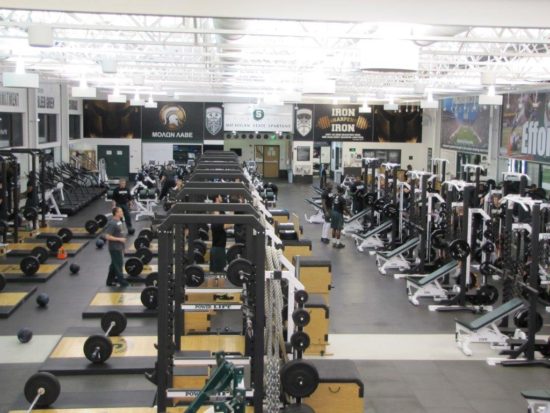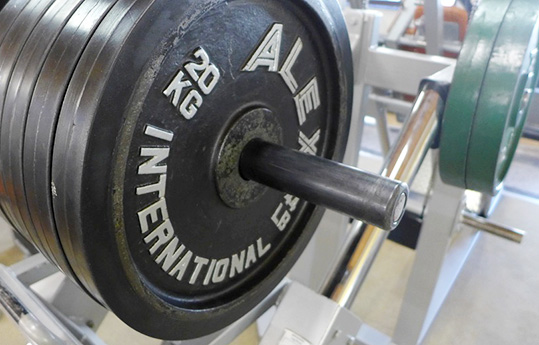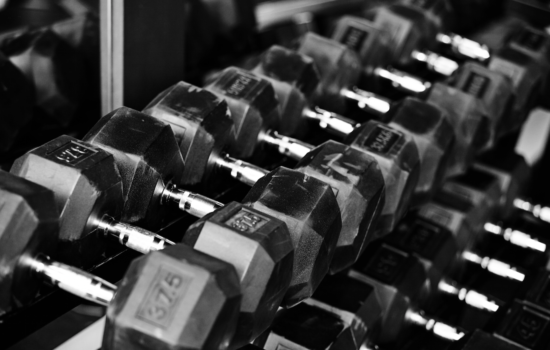Strength and conditioning experts offer their best tips

Strength and conditioning programs at the high-school level vary greatly from wealthy districts that can afford some of the best equipment and top coaches to the less-affluent areas, where old equipment is cherished and coaches may have less experience.
Regardless of size, funding or number of coaches, high school programs are similar in that they’re working to develop the bodies of 14- to 18-year-old males and females. With that in mind, Coach & Athletic Director asked an esteemed panel of experts for their tips on a variety of topics pertaining to all high school strength and conditioning programs. They discussed differences in gender training, offseason workouts, sanitation (cleanliness) in the weight room, how to schedule enough time with all of your athletes, buying new equipment, stretching, setting up your weight room, supervision in the weight room, speed and explosiveness, core training and more.To help us out, we reached out to this group of experts:
- Kevin Vanderbush, CSCS, strength coach, Ben Davis High School (Indianapolis, Indiana)
- Mike Nitka, director of human performance, Muskego High School (Muskego, Wisconsin)
- Doug Bull, MS, CSCS, district strength & conditioning coordinator, Deer Park High School (Deer Park, Texas)
- Rick Howard, director of athletics, school district of Philadelphia
- Patrick McHenry, MA, CSCS*D, strength & conditioning coach, Castle View High School (Castle View, Colorado)
- Brian McGladrey, Ph.D., CSCS, assistant professor, sport coaching education, University of Southern Mississippi (Hattiesburg, Mississippi). McGladrey coached high school baseball for 12 years
- Pierre Steenekamp, president, Legend Fitness
- Dr. Bruce Sherman, president, GymValet
Gender differences
When coaching males and females, the experts provided these tips.
McHenry: Males and females have different injury issues, so focus on an ACL prevention program as a warm-up for females. Also, focus on females’ upper back and shoulders. One area to keep the same for both males and females is technique. Focus on quality first, then go into specific lifts and exercises.
Vanderbush: For the most part, we train male and female athletes the same. They have the same base program for the lift selection, set (and rep) scheme and the general athletic enhancement activities. The differences, although minimal, occur with some of the motivational techniques used. There are certain motivators that tend to be gender specific.
Nitka: We train the male and female athletes similarly. They all learn how to bench, squat, deadlift and clean. We will, however, pay attention to our female athletes as we teach them how to jump, land and decelerate.
Bull: We don’t train males and females differently. We train sports differently. For female athletes, place a greater emphasis on the deceleration aspect of lower-body movements to reduce incidents of ACL injuries.
Howard: Individualize training programs at the high school level not only by sport but by response and adaptation to sport-fitness profiles based on Peak Height Velocity measurement.
Offseason training
Offseason training revolves around goal-setting, according to our panel. Here are their best tips to get the most out of your athletes’ time away from your direct supervision.
McGladrey: During the offseason (time away from school), have athletes train with enough frequency, volume and intensity so that time is not lost playing catch-up in the weight room when school resumes.
 Vanderbush: The offseason provides an opportunity to spend more time working with certain teams or individuals on areas that cannot be developed in-season due to time or priority restraints. As an example, in the offseason (winter) the football team lifts during the strength-training class and again after school four days per week to increase the lifting volume with the goal of putting on size and increasing strength. In the spring, they transition to two after-school lifting sessions and two days of football-specific speed development.
Vanderbush: The offseason provides an opportunity to spend more time working with certain teams or individuals on areas that cannot be developed in-season due to time or priority restraints. As an example, in the offseason (winter) the football team lifts during the strength-training class and again after school four days per week to increase the lifting volume with the goal of putting on size and increasing strength. In the spring, they transition to two after-school lifting sessions and two days of football-specific speed development.
Bull: Reduce the incident of injury while improving performance. Train your athletes to be as explosive and efficient as possible.
McHenry: In the first part of the offseason, focus on recovery, then areas that need improvement (and injury prevention). Finally, get them ready for next season.
Monitoring offseason
After the goals are set and the programs are in place, coaches still need to make sure the athletes are following through on their plans. Here are some ideas on how to keep tabs on your players.
Nitka: Our athletes check in and out each day. As they check in, we give them their program and collect it after they finish. Programs not picked up are placed in a separate pile indicating to us that they were absent. We will speak with them the next time they show up. If our athletes have three unexcused absences, they are dismissed from the program for the remainder of the cycle.
Bull: All of our athletes (700 plus) get a weekly workout sheet (Strength Tracker) that provides them with the sets and reps for each exercise, and the weight that should be on the bar. Print off sheets for the coaches so they can check the accuracy of the athletes weights. Depending on the sport, have anywhere from one to eight coaches in the weight room monitoring the workout.
Vanderbush: All of our athletes are in a strength-training class during the school day, so whether in-season or out of season, we know that they’re completing the base program we developed. Those sports that incorporate after-school sessions utilize attendance boards, motivational T-shirts, individual evaluation (goal-setting sessions) and, as a last resort, parent involvement to encourage participation.
McHenry: Track athletes with their lifting card. This allows you to monitor their volume, exercises and the weight they’re using. Most of my athletes are in a class, so I can track their performance tests (e.g. vertical jump, 10-yard sprint, pro agility), and this allows me to see if they’re overtraining.
McGladrey: I monitor my athletes during the offseason with use of emails and text messages, and ask them to report their training activity. Once back at school, testing and evaluation reveal athletes’ adherence to the offseason program.
Weight room cleanliness
If bacteria or viruses find their way into your weight room, your entire athletic program is put at risk. Today’s players need to be cognizant of hygiene, cleanliness and caring for the equipment and facilities as if they are their own.
 Sherman: Don’t let MRSA or other bacterial or viral infections derail your strength and conditioning programs. Regular user-to-user sanitizing (disinfecting) of body-contact surfaces on strength training and conditioning equipment is the best way to prevent the spread in your facility. Bacteria and viruses are easy to kill on hard surfaces; much harder to kill once they invade the body. A safe workout environment must be a combined effort between a facility’s staff and athletes. Protect your investment in your athletes and your equipment with regular equipment cleaning.
Sherman: Don’t let MRSA or other bacterial or viral infections derail your strength and conditioning programs. Regular user-to-user sanitizing (disinfecting) of body-contact surfaces on strength training and conditioning equipment is the best way to prevent the spread in your facility. Bacteria and viruses are easy to kill on hard surfaces; much harder to kill once they invade the body. A safe workout environment must be a combined effort between a facility’s staff and athletes. Protect your investment in your athletes and your equipment with regular equipment cleaning.
McGladrey: Weight room rules need to be posted and communicated, and athletes need to understand the consequences for the lack of adherence to the rules. Just like on the playing field, athletes are assigned responsibilities for keeping the weight room clean and orderly.
McHenry: Keep a cleaning log so you know what has been handled from a cleaning standpoint. Talk to the school custodians so you are on the same page. Spray down all the pads before you leave every night with a disinfectant. Have custodians sweep or mop the floor and share the cleaning of the mirrors. Before each break, clean all the benches, machines and racks.
Bull: We have an incredible facility for which our athletes have a great deal of pride. Every group that comes through the weight room puts every weight, bench, bar and technique box back where they belong before they leave the room. Try implementing a “cleaning fee” to ensure that this happens. Have student aides help disinfect equipment.
Vanderbush: Specific guidelines and high expectations are a necessity. All of your athletes and coaches should know where things belong and what the rules are. Each individual is responsible for putting things back where they found them. Stress pride in your facility, which results in clean-up as a regular part of the routine.
Weight-room organization
Every weight room is different in terms of size and shape. With that in mind, when planning how to use your space, there are some general rules to keep in mind to get the most effective use of the area.
Steenekamp: Priority No. 1 is planning. Before buying and installing equipment, plan the floor layout to focus on functionality, transitions and utilization. That ensures that coaches are putting in the right equipment, in the correct quantities and in the best layout to get the most out of the equipment, reduce transition times, and provide the athletes with the best combination of space and equipment to maximize training efficiencies.
Managing schedules
With every athletic team gaining an advantage by putting in the proper time in the weight room, it’s critical that your strength staff — even if it’s just you — devises a schedule to allow all athletes a maximum amount of time in your facilities. Here is how our experts handle scheduling.
McHenry: Have your coaches help you out. Encourage them to ask when the room is not busy, so you can schedule their team. Getting ready for spring sports, have coaches work with their athletes first and then come in after other teams used the room. See if you can get some coaches to schedule workouts before school. Also, request that some teams only send in part of the team at a certain time, then send in the remainder of the athletes when the first group is done.
Bull: Focus on having teams use your facility based on time of season and athletic periods. Generally, our games are on Tuesdays and Fridays, so our in-season sports lift on Wednesday afternoon and Saturday morning. For the other sports, we have three athletic periods that enable our athletes to use the facility during the day.
Vanderbush: During the school day, our athletes are assigned to a specific Advanced Weight Training class period based on their participation sport. Compile a list of your athletes and provide your guidance staff with a spreadsheet to help them determine scheduling preferences. During the summer, have the athletes fill schedule time blocks based on their sport. This allows sport coaches to actively participate during the time that their athletes are present.
McGladrey: In-season athletes should be granted priority for weight-room use. Only athletes who are supervised by qualified coaches (teachers) may use the weight room.
Click here to continue reading
One thought on “Strength and conditioning experts offer their best tips”
Leave a Reply
You must be logged in to post a comment.



Thank you for your tip to focus on technique for both male and female athletes. My brother is a soccer coach and he wanted to look up some tips for improving his team’s speed. I wonder if there is a sports speed training program that he could utilize.